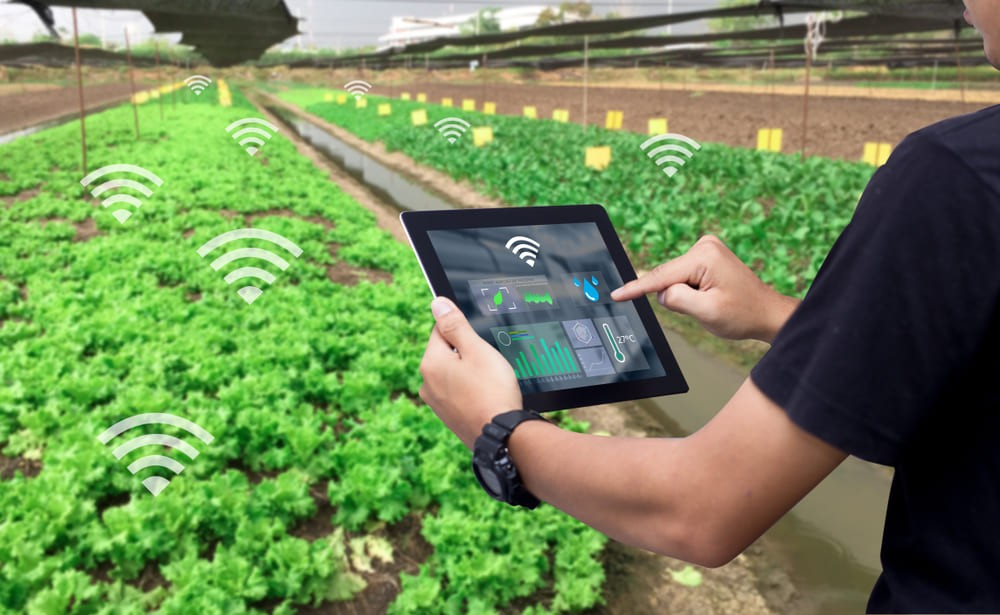Introduction
IoT is revolutionizing almost every aspect of our lives by changing how we do things. Investing in IoT enhances operations efficiency and product quality and decreases production costs. The Agricultural industry is among the initiatives seeking to reap the benefits of IoT. The use of IoT in agriculture is commonly referred to as Smart farming.

The IoT technology has realized Smart habits, connected appliances, computerized machines, and uncrewed cars. Although, in agriculture, the IoT has brought the most significant impact under IoT solutions. Recent statistics reveal that the global population will reach 9.6 billion by 2050. And to sustain this vast population, the agriculture industry is surrounded by acquiring the IoT under IoT solutions.
Smart farming and IoT-driven agriculture are assigning the groundwork for a "third green revolution," which mentions the integrated application of data and communications techniques under IoT solutions. It includes devices such as precision equipment, IoT sensors and actuators, geo-positioning systems, crewless aerial vehicles, and robots.
IoT technology helps control agriculture processes to reduce production risks and enhance the ability to foresee production results, allowing farmers to plan better and distribute the product under IoT solutions. Data about identical batches of crops and the number of crops to harvest can help farmers cut down on labor and waste under IoT solutions.
Akenza.io
While talking about IoT solutions, akenza.io is the self-service IoT platform, allowing you to build great IoT products and services with value under IoT platforms. It connects, controls, and manages IoT devices in one place.
Akenza.io provides a cloud-based system that connects everyThing to the cloud.
IoT based Smart farming brings a revolution in the agriculture industry such as:
Climate Conditions:
Climate plays a very critical role in farming. And having improper knowledge about the environment and the environment strongly deteriorates the quantity and quality of crop production under IoT solutions.
But IoT solutions allow you to know the real-time weather circumstances. Sensors are situated inside and outside of the agriculture areas. They collect information from the environment, which is used to choose the suitable crops which can rise and keep in the particular climatic conditions under IoT solutions.
The IoT ecosystem comprises sensors that accurately ascertain real-time weather conditions like humidity, rainfall, temperature, and more under Smart farming.
Precision Farming:
Precision farming is the most popular implementation of IoT in Agriculture. It assembles the farming practice more precisely and is controlled by realizing innovative farming implementations such as livestock tracking, vehicle tracking, field observation, and inventory observation under IoT solutions.
Precision farming aims to analyze the data generated via sensors and react accordingly. Precision farming helps farmers create data with the help of sensors and analyze that information to make intelligent and quick decisions under Smart agriculture.
With the support of Precision Farming, you can analyze soil conditions and other related parameters to increase the operational efficiency under IoT solutions. Not only this, but you can also detect the real-time working conditions of the connected devices to detect water and nutrient levels under IoT solutions.
Smart Greenhouse:
To create our greenhouses Smart, IoT has enabled weather stations to automatically adjust the climate conditions according to a particular set of instructions under Smart farming. Adopting IoT in Greenhouses has eliminated human intervention, thus making the entire process cost-effective and increasing accuracy simultaneously under IoT solutions.
Data Analytics:
The standard database system does not have sufficient storage for the data collected from the IoT sensors. Cloud-based data storage and an end-to-end IoT platform are essential under IoT solutions in the Smart agriculture system.
Applicability of IOT in agriculture
Smart farming is a hi-tech and effective agriculture system and sustainably grown food. Smart farming is majorly established on IoT, thus eliminating the need for physical work of farmers and growers and thus enhancing productivity in every possible method under IoT solutions. It is a request to implement connected devices and innovative technologies in agriculture under IoT solutions.
With the latest agriculture trends dependent on agriculture, the Internet of Things has brought huge benefits like a well-organized use of water, optimization of inputs, and many more under IoT solutions. What made a difference were the vast benefits that have revolutionized agriculture recently under Smart farming.
IoT-based Smart farming improves the entire Agriculture system by monitoring the field in real-time. It checks various factors like humidity, temperature, soil, etc., and gives crystal precise real-time observation under IoT solutions. With the support of sensors and interconnectivity, the Internet of Things in Agriculture has saved the farmers' time. Still, it has also reduced the extravagant use of water and electricity resources under IoT solutions.
Conclusion:
IoT-enabled agriculture has helped implement modern technological solutions to time-tested knowledge. It has helped bridge the gap between production, quality, and quantity yield under Smart farming. Data ingested by obtaining and importing information from the multiple sensors for real-time use or storage in a database ensures swift action and minor crop damage under IoT solutions. With seamless end-to-end intelligent operations and improved business process execution, produce gets processed faster and reaches supermarkets in the quickest time possible under Smart farming.







0 Comments